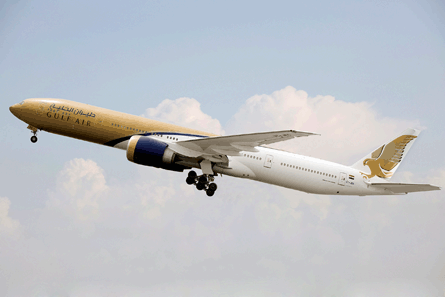Gulf Air was the original network carrier, linking four hubs across the Gulf with an international route map that spanned the globe. But after a succession of ownership changes that saw first Qatar, then Abu Dhabi, and finally Oman go their separate ways, the airline is now focused on a single-hub operation from the international airport of its single shareholder, Bahrain.
Gulf Air operates in the shadow of its local rivals, as it lacks their deep pockets and unlimited growth aspirations. The airline has just begun a partial rollover of its long-haul fleet which will see four new Boeing 777-300ERs replace some of its ageing Airbus A340-300s.
Five new Airbus A320s and four A330s will also arrive this year, with the former enabling some of its oldest Airbus narrowbodies to be retired.
The loss-making airline has an impressive order backlog - 20 A320s, 15 A330s and 16 787s - and aims to grow capacity by 10% a year, but is keeping a firm hand on costs as it looks to return to profit.
 |
|---|
© Gulf Air |
"We need to make sure our overheads don't grow," says chief executive Bjorn Näf, confirming that the carrier had imposed a "headcount freeze" that has since been tightened to a hiring ban. "People who leave us, we're not replacing."
Näf says Gulf Air needs to increase productivity and will "filter out the people who have been riding the train".
Like its neighbours, Gulf Air has traditionally relied heavily on expatriates - it employs 74 nationalities of cabin crew and in the past 12 months has recruited flight attendants from Europe as well as Morocco, Tunisia, Nepal and Bangladesh.
The carrier's operations division provides training for cabin crew, pilots, ground operations and maintenance at the airline's head office in Bahrain.
From a flightcrew perspective, the carrier does not recruit captains directly because promotions come from within its first officer community. It has three possible entry streams for first officers - direct-entry type-rated pilots must be under 51 years old and need a minimum of 1,500h, including 250h on type, and 500h on multi-crew jets, or a minimum of 700h including 500h on the type selected to fly.
"We must raise productivity and filter our the people who have been riding the train"Bjorn Näf - Gulf Air chief executive |
|---|
Direct-entry non-type-rated pilots with jet experience must be under age 46 and have a minimum of 1,500h including 500h on multi-crew jets.
Similarly, direct-entry non-type-rated pilots without jet experience must be under 46 years old and have at least 2,000h experience, of which 1,000h are on multi-crew aircraft with a maximum take-off weight of at least 20,000kg (6,100lb).
All air crew applicants need at least a frozen ATPL (JAA Equivalent), English language proficiency (written and verbal) and a current medical.
For the expatriate worker, Bahrain has a lot to offer, not least its zero income tax. The climate is good, too, with pleasant conditions - bar the four hottest months of the year, which begin in May - of continuous sunshine and blue skies. Gulf Air says that Bahrain is "one of the most liberal and modern Arabian Gulf states".
It is unclear how long the recruitment freeze will last, but the airline is moving ahead with its "3/3/10" long-term expansion plan to add three aircraft, three destinations and 10% capacity growth each year. The fleet now comprises about 30 aircraft, which serve a route network of 42 destinations.
Näf expects the improved reliability and more modern cabins offered by the its newly delivered 777s will help boost Gulf Air's business in 2009, when it targets an 8% increase in passenger numbers over the "almost six million" carried in 2008.
The aim is to be back in profit - or close to recovery - next year.
Source: Flight International
















